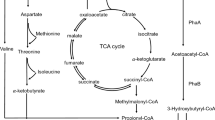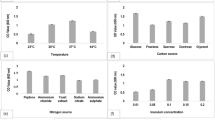Abstract
Integrative processes for the production of bioenergy and biopolymers are gaining importance in recent years as alternatives to fossil fuels and synthetic plastics. In the present study, Bacillus thuringiensis strain EGU45 has been used to generate hydrogen (H2), polyhydroxybutyrate (PHB) and new co-polymers (NP). Under batch culture conditions with 250 ml synthetic media, B. thuringiensis EGU45 produced up to 0.58 mol H2/mol of glucose. Effluent from the H2 production stage was incubated under shaking conditions leading to the production of PHB up to 95 mg/l along with NP of levulinic acid up to 190 mg/l. A twofold to fourfold enhancement in PHB and up to 1.5 fold increase in NP yields was observed on synthetic medium (mixture of M-9+GM-2 medium in 1:1 ratio) containing at 1–2 % glucose concentration. The novelty of this work lies in developing modified physiological conditions, which induce bacterial culture to produce NP.

Similar content being viewed by others
References
Kalia VC, Purohit HJ (2008) Microbial diversity and genomics in aid of bioenergy. J Ind Microbiol Biotechnol 35:403–419
Singh M, Patel SKS, Kalia VC (2009) Bacillus subtilis as potential producer for polyhydroxyalkanoates. Microb Cell Factories 8:38
Hallenbeck PC, Ghosh D, Skonieczny MT, Yargeau V (2009) Microbiological and engineering aspects of biohydrogen production. Indian J Microbiol 49:48–59
Porwal S, Kumar T, Lal S, Rani A, Kumar S, Cheema S, Purohit HJ, Sharma R, Patel SKS, Kalia VC (2008) Hydrogen and polyhydroxybutyrate producing abilities of microbes from diverse habitats by dark fermentative process. Bioresour Technol 99:5444–5451
Patel SKS, Singh M, Kalia VC (2011) Hydrogen and polyhydroxybutyrate producing abilities of Bacillus spp. from glucose in two stage system. Indian J Microbiol 51:418–423
Reddy CSK, Ghai R, Rashmi, Kalia VC (2003) Polyhydroxyalkanoates: an overview. Bioresour Technol 87:137–146
Ntaikou I, Kourmentza C, Koutrouli EC, Stamatelatou K, Zampraka A, Kornaros M, Lyberatos G (2009) Exploitation of olive oil mill wastewater for combined hydrogen and biopolymer production. Bioresour Technol 100:3724–3730
Venkata Mohan S, Reddy MV, Subhash GV, Sarma PN (2010) Fermentative effluents from hydrogen producing bioreactor as substrate for poly(β-OH) butyrate production with simultaneous treatment: an integrated approach. Bioresour Technol 101:9382–9386
Yan Q, Zhao M, Miao H, Ruan W, Song R (2010) Coupling of the hydrogen and polyhydroxyalkanoates (PHA) production through anaerobic digestion from Taihu blue algae. Bioresour Technol 101:4508–4512
Kalia VC, Lal S, Ghai R, Mandal M, Chauhan A (2003) Mining genomic databases to identify novel hydrogen producers. Trends Biotechnol 21:152–156
Kalia VC, Chauhan A, Bhattacharyya G, Rashmi (2003) Genomic databases yield novel bioplastic producers. Nat Biotechnol 21:845–846
Kumar T, Singh M, Purohit HJ, Kalia VC (2009) Potential of Bacillus sp. to produce polyhydroxybutyrate from biowaste. J Appl Microbiol 106:2017–2023
Patel SKS, Singh M, Kumar P, Purohit HJ, Kalia VC (2012) Exploitation of defined bacterial cultures for production of hydrogen and polyhydroxybutyrate from pea-shells. Biomass Bioenergy 36:218–225
Tajima K, Igari T, Nishimura D, Nakamura M, Satoh Y, Munekata M (2003) Isolation and characterization of Bacillus sp. INT005 accumulating polyhydroxyalkanoate (PHA) from gas field soil. J Biosci Bioeng 95:77–81
Valappil SP, Rai R, Bucka C, Roy I (2008) Polyhydroxyalkanoate biosynthesis in Bacillus cereus SPV under varied limiting conditions and an insight into the biosynthetic genes involved. J Appl Microbiol 104:1624–1635
Patel SKS, Purohit HJ, Kalia VC (2010) Dark fermentative hydrogen production by defined mixed microbial cultures immobilized on ligno-cellulosic waste materials. Int J Hydrogen Energy 35:10674–10681
Kalia VC, Joshi AP (1995) Conversion of waste biomass (pea-shell) into hydrogen and methane through anaerobic digestion. Bioresour Technol 53:165–168
Patel SKS, Kumar P, Kalia VC (2012) Enhancing biological hydrogen production through complementary microbial metabolisms. Int J Hydrogen Energy 37:10590–10603
Patel SKS, Kalia VC (2012) Integrative biological hydrogen production: an overview. Indian J Microbiol. doi:10.1007/s12088-012-0287-6
Kalia VC, Raizada N, Sonakya V (2000) Bioplastics. J Sci Ind Res 59:433–445
Kalia VC, Jain SR, Kumar A, Joshi AP (1994) Fermentation of biowaste to hydrogen by Bacillus licheniformis. World J Microbiol Biotechnol 10:224–227
Labuzek S, Radecka I (2001) Biosynthesis of copolymers of PHB tercopolymer by Bacillus cereus UW85 strain. J Appl Microbiol 90:353–357
Mizuno K, Ohta A, Hyakutake M, Ichinomiya Y, Tsuge T (2010) Isolation of polyhydroxyalkanoate-producing bacteria from a polluted soil and characterization of the isolated strain Bacillus cereus YB-4. Polym Degrad Stab 95:1335–1339
Van der Voort M, Abee T (2009) Transcriptional regulation of metabolic pathways, alternative respiration and enterotoxin genes in anaerobic growth of Bacillus cereus ATCC 14579. J Appl Microbiol 107:795–804
Kalia VC, Purohit HJ (2011) Quenching the quorum sensing system: potential antibacterial drug targets. Crit Rev Microbiol 37:121–140
Kalia VC, Raju SC, Purohit HJ (2011) Genomic analysis reveals versatile organisms for quorum quenching enzymes: acyl-homoserine lactone-acylase and -lactonase. Open Microbiol J 5:1–13
Acknowledgments
The authors wish to thank Director of CSIR-Institute of Genomics and Integrative Biology and Department of Biotechnology, Government of India for providing the necessary funds, facilities and moral support. M. Singh and P. Kumar are thankful to UGC and CSIR for Senior Research Fellowships and S.K.S. Patel to CSIR for Research Associate Fellowship.
Author information
Authors and Affiliations
Corresponding author
Rights and permissions
About this article
Cite this article
Singh, M., Kumar, P., Patel, S.K.S. et al. Production of Polyhydroxyalkanoate Co-polymer by Bacillus thuringiensis . Indian J Microbiol 53, 77–83 (2013). https://doi.org/10.1007/s12088-012-0294-7
Received:
Accepted:
Published:
Issue Date:
DOI: https://doi.org/10.1007/s12088-012-0294-7




